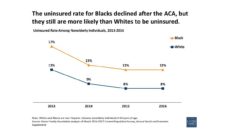One way the Trump Administration attempted to dismantle the Affordable Care Act (ACA) is by issuing regulations that allow for new understandings of certain ACA provisions, making it easier for individuals, employers, and insurers to skirt key ACA requirements. Earlier this year, I wrote about how new Trump regulations expanding access to short-term limited duration insurance (STLDI) can be harmful to the individuals who purchase it. More recently, a new rule significantly changes the way association health plans (AHPs) are regulated. And this time, it’s not only individuals who could suffer, but also small employers (<50 employees) that would be able to join AHPs more easily without perhaps knowing the devastating history of AHPs.
AHPs were developed in the late 1990s to make it easier for small employers to band together to purchase health insurance as a large group with a larger risk pool. The goal was to lower costs for these employers and their employees. Because more people would be contributing to the health plan, the price would be less for everyone.
But many AHPs filed for bankruptcy during that time, leaving countless people with unpaid claims. One report from the early 2000s found that 200,000 policyholders were left with unpaid medical bills totaling $252 million. Some people who believed they were paying their premium each month would arrive at a medical visit to find out the plan didn’t exist or had been terminated.
The new Trump administration regulations governing AHPs make no mention of the long history of fraud and abuse, nor do they tighten the regulation of AHPs. Instead, they make it easier to sell AHPs that do not adhere to ACA requirements. The laws governing AHPs are also incredibly complicated, so state and federal oversight is poor. The confusion is part of why AHPs became defunct in the 1990s.
The states argue the Trump administration’s interpretation of how AHPs can form and who can join them is unlawful and a blatant attempt to dismantle the ACA through executive action.
When AHPs are formed, they’re treated like large group health plans, the kind of plan you would typically be offered by a large employer (>50 employees). The ACA does not apply to many large group plans because most of them already offer good benefits. So, unlike individual and small group coverage, large group health insurance has been exempt from many ACA requirements.
Soon after the new rules on AHPs were issued, eleven states and the District of Columbia sued the Department of Labor. The states argue the Trump administration’s interpretation of how AHPs can form and who can join them is unlawful and a blatant attempt to dismantle the ACA through executive action.
For example, the new rule redefines “employer” such that sole-proprietors and self-employed individuals without employees could qualify for an AHP as an “employer,” rather than purchase insurance from the individual market as the ACA intended. The rule also allows small employers to band together to form an association solely for the purpose of offering health benefits, which longstanding regulations have prohibited.
In March, the court found the states’ argument compelling and invalidated the final rule. Immediately following the decision, the Department of Labor announced their intent to appeal the decision, sewing more confusion and uncertainty about health insurance and the ACA. The future health and health care of tens of thousands of Americans is in jeopardy as the undermining of the ACA, which has benefited millions, remains under attack.
Photo by Bill Oxford on Unsplash














